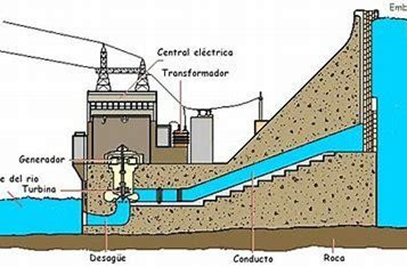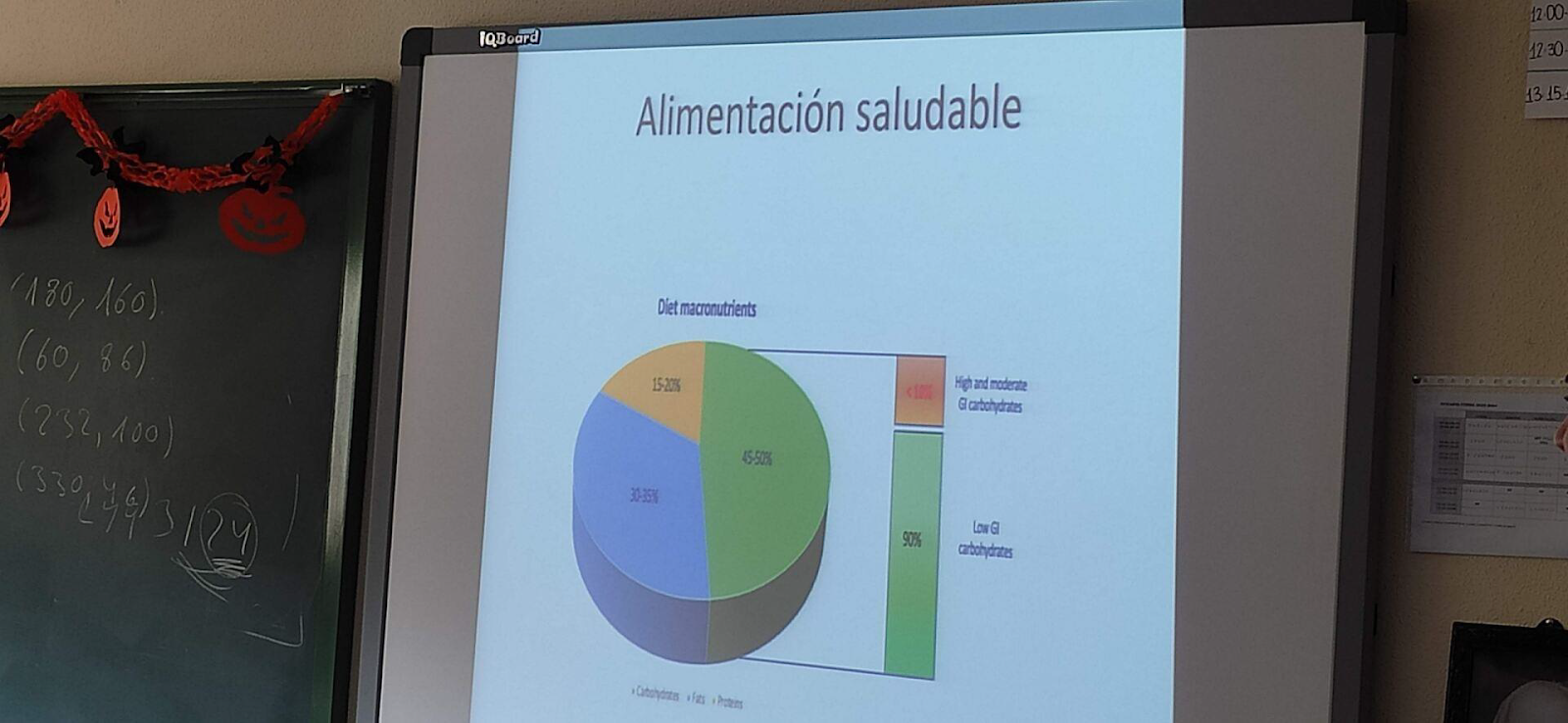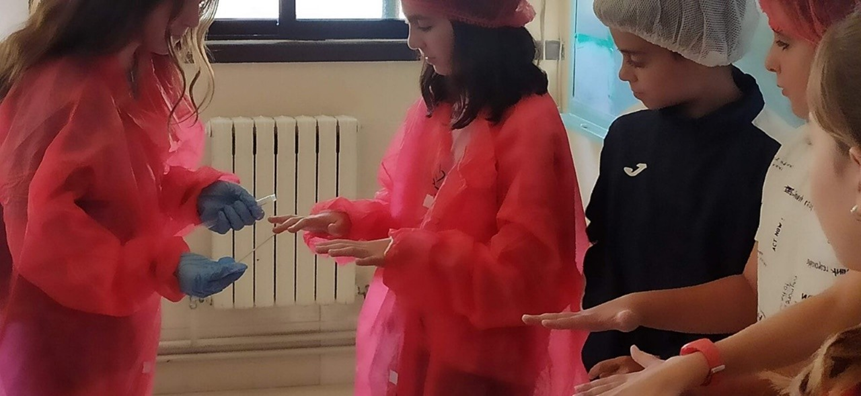25/1/2024
Last Tuesday, January 16, an engineer named Antonio (the father of a student known as Clara) came to the school Jose Maria de la Fuente to talk with them about energy. He knew many things because he has been working with energy for 20 years.
First, he warned us that when we saw warning signs we could not touch him because we could electrocute. Then he told us different forms of energy there and explained them one by one and very clearly.Then he went into more detail on the subject he deals with the most: the mills.
When he explained it to us we were surprised that mills could be installed in the water! He also explained that the mills were put in places where there was a lot of air.The mills transform wind energy into electricity with a generator. The mills normally measure 334 meters and is larger than the Eifell Tower.
Entering the world of energy that tests water we can discover that when the water impacts creates mechanical energy and people working in this type of energy installed a turbine next to a generator so that when the mechanical energy of the water rotates the turbine which will produce more mechanical energy than going to a generator , which will transform mechanical energy into electricity.
In my opinion I think that the talk was very interesting and funny because he prepared some games and he explained very clearly.
By Sergio Paredes Merlo (6th C).
6/11/2023
EXPERIMENTS IN 6th A
"Volcano on fire in the classroom"
With some spoonfuls of vinegard and bicarbonate of soda, Amelia has created an erupting volcano inside the classroom. After mixing these substances carbon dioxide is formed, forcing the content of the bottle to come out of it, making the same effect as real volcanoes.
"Sand that doesn't get wet"
After sprinkling with some waterproof spray a small quantity of sand and waiting for a couple of hours, Candela has achieved that this sand doesn't soak in water!
"Rain of colours"
In this experiment, Iria has made a wonderful colourful rain in a jar of water. Mixing water, oil and colourant has demonstrated how different densities can produce this incredible effect. First, you have to mix water and oil. As it is known, the oil has more density and stays on top of a jar and when you add the colourant to the mix, these start to fall down little by little.
"Water that doesn't fall"
With a glass recipient with water, a tight and an elastic band, Eugenia has tried to make water fall through the tight but it didn't fall (at the beginning, later it has been falling little by little). Thanks to the surface tension of water itself, the surface of water ends up acting as an elastic membrane blocking the content of the recipient from pouring.
EXPERIMENTS IN 6th B
"Floating Candle"
Alberto has shown in class the force of the atmospheric preassure with a glass, a plate, water and a candle. Once the candle is lighted, it is consuming all the oxygen, so the preassure inside the glass starts to be lower and the water level rises.
"How to introduce a egg in a bottle"
Jimena and Lucia M.
"The egg that bounces"
Laura E.
"A Rainbow"
Samuel and Germán
"The Volcano"
Mª Isabel and Lucia P.
EXPERIMENTS IN 6th C
"Jumping egg"
Rocío has shown us how you can become an egg in a bouncy item after sinking it in vinegard for two days. The acid properties of the vinegard and the calcium carbonate of the shell creates a chemical reaction that disolves this shell. Thi does not mean that the egg can't be broken
.png)
.png)
6/11/2023
THE NUTRITION IMPORTANT
In the 24 th of October Paloma Donado Palencia the Mother of Laura Luna gave us a workshop of nutrition that explain the important of eat healthy
This workshop where in the clas s of 6 A.
The nutrition help us the function of organs and systems, daily activities and grow Trought the aliments has obtein the nutrients and the energy
Complete every nutrients : Proteins, carbohydrates, fats, vitamins and minerals to obtain energy and prevent diseases
Macronutrients Carbohydrates, fats and proteins.
Micronutrients:
Vitamins, minerals and water.
Diet macronutrients 15 20 % are proteins 30 35 % are fats 45 50% are carbohydrates
COMPLEX COMPLEX CARBOHYDRATESCARBOHYDRATES
Energy
Energy aliments are aliments are carbohydratescarbohydrates: : Cereals, bread, pastaCereals, bread, pasta and potatoes.and potatoes.
Carbohydrates complex in hydrates complex in ccerealsereals:: StarchStarch
Carbohydrates complex in bread
Carbohydrates complex in bread:: FlourFlour
Carbohydrates complex in pasta:
Carbohydrates complex in pasta: FlourFlour
Carbohydrates complex in
Carbohydrates complex in potatoes: Potatoespotatoes: Potatoes
SIMPLE CARBOHYDRATES SIMPLE CARBOHYDRATES
Sugars are a simple type of
Sugars are a simple type of carbohydratecarbohydrate:: Sucrose, lactose,Sucrose, lactose, fructose and fructose and glucose.glucose.
Types of sugarsTypes of sugars:: CakesCakes, sweet, candies and sugary drinks, sweet, candies and sugary drinks..
SIMPLEX COMPLEX
Increase quickly the sugarthe sugar Increase gradually the sugar in the bloodIncrease gradually the sugar in the blood in the bloodin the blood
Coookies, kies, pastries and pastries and cereals cereals breakfast .breakfast .
Our nutritionalnutritional worthworth depend depend in its way in its way of elaboration of elaboration and the products and the products that that are are added added to the base to the base flour.flour.
Meats,
Meats, eggs, eggs, fish, fish, pulses and nuts pulses and nuts are foods that contain are foods that contain proteinsproteins..
Spain is the first European country first European country and the and the fifth fifth mundial country that much mundial country that much consume consume meat. meat.
Vegetables and fruit are regulatefruit are regulate aliments. aliments.
This Aliments are formed the plate of Aliments are formed the plate of Harvad.Harvad.
Important of read the etiquetsread the etiquets::
CompositionComposition
Type of fat
Type of sugar. Simple sugar
This workshop
This workshop are very important for eat healthy are very important for eat healthy
that explain the amount of amount of foodfood prepare prepare in in your your plate that eat more healthy.
Other interesting articles about the workshop:
JMF receives another guest by Amelia Tonelo Delgado (6th A)
A healthy diet by María Sánchez de la Nieta (6th C)
19/10/2023
SAFETY FOOD IN JMF
Last Monday,
October 9, Vanesa (Jimena’s mother) came
to our school to talked about safety food.
All students of 6º of Primary were in our class (6º A) participated Jimena, Lucía M, Lucía P,
Alex, Paula and Samuel.
All students
of 6º of Primary in the workshop
Vanesa projected a Power Point about Food Bacterias and Foodborne
Infection.
Vanesa talked about what bacteria need to grow:
1.
Nutrients
2. A good temperature (between 5ºC-65ºC)
3. Humidity (Vegetables, meat and fish need to be preserved in fridge and cereals, flours, rice,cookies,...can be preserved at ambient temperature)
Vanesa explained us three types of infections: Salmonelosis, Botulims and Staphylococcus Aureus and how we can prevent them.
For example, to prevent salmonelosis, we need to place well
the fridge: raw
food at the bottom, cooked food at the top and protect the
food.
Vanesa also talked about labelings parts: company
brand, the name of the food, list of ingredients, allergens, shelf life, store
conditions, nutritional information, date of expiry,...
After that, Vanesa gave us ... real bacteria!!! There were in a specific plastic box.
And finally, some kids dressed up as scientists and Jimena took bacteria of their hands, put bacteria
in a specific box and now we
are expecting that bacteria grow.
Jimena caught
bacteria from hands
The workshop
was very interesting and funny.
I learned a lot about how to use and keep aliments. It was very
funny when Jimena caught bacteria and we are waiting to see bacteria.
I want to repeat!
Iria López González 6ºA
Links to other articles about this workshop:
Food Safety Workshop in our school - Carmen Murillo 6th C
Vanessa's workshop in JMF - Jimena Serradilla 6th B
9/6/2023
As said in previous days, the 5th level students have carried out the project of the 'Time machine'. Some journalists have travelled in time and have interviewed different historical characters in Spanish history such as a Roman, a Visigoth, a Muslim, the Catholic Monarchs, Christopher Columbus, Charles I, Philip II, Philip V, etc....They have worked very hard and have done an excellent job. Congratulations!!
These are some of the interviews.
23/5/2023
The 5th level students have created a time machine that will allow them to travel in time. In the following weeks they will travel to the different periods in history to study how Spain was in the past.
This is the video of the scientist that have created the 'Time Machine'.
Introduction to the Time Machine.
26/4/2023
Students of 5th course participated in the workshop "EL GUADIANA DESDE EL FONDO: un viaje desde las profundidades". Two enviromental educators have visited our school to show us the importance of water in our lives and how is a river. The workshop allowed us to experiment how is an aquifer (Acuífero 23), what is on the surface of a river and what under the water.
We have seen the fauna and flora of the Guadiana and do different experiments to know more about this river.
26/4/2023
The 5th level students have been studying recently the autonomous communities of our country and have prepared some written and oral projects about the most important of them. Here are some of these projects.
We hope you enjoy them!
27/2/2023
Throughout this school year, the students of the fifth level have been creating interesting projects in the Natural and Social Science subject. In the first term, they did some nice PowerPoint presentations about a living thing and this term they have done a research about wetlands and rivers. Here you can have a look at them. Enjoy them!.





.png)
.png)
.png)
.png)
.png)








.png)
.png)
.png)
.png)















2.png)








.png)









.jpg)


No hay comentarios:
Los comentarios nuevos no están permitidos.